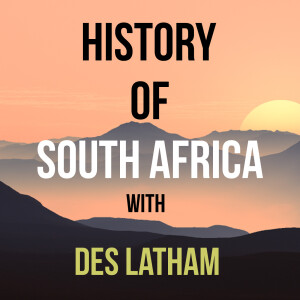
History of South Africa podcast
History

Episode 9 –KhoeKhoe power networks and the Dutch create the VOC charter company
 2021-04-11
2021-04-11
Download
Right click and do "save link as"
IT was only in 1610 that the Dutch discovered the advantages of sailing east from the Cape before swinging north to reach the hub of their trading network in Java. As a result, contacts between the Khoekhoe and the Europeans steadily increased particularly around Table Bay.
In the first half of the 17th Century a regular system of trade developed between the Khoekhoe of the southwestern Cape and the visiting sailors. It boiled down, if you excuse the pun, to sheep and cattle exchanged for metals initially iron, but then brass and copper.
The Khoekhoe as we heard last episode were not interested in the baubels and trinkets dished up by would-be traders earlier and the Europeans learned very swiftly to trade valuable goods for valuable foods.
Unlike the farmers of eastern southern Africa, the Khoekhoe could not manufacture iron themselves but knew how to smelt metal.
The Tswana/Sotho and Nguni were already mining and smelting iron but in essence the KhoeKhoe remained what is known as stone age people. This is not an insult, its how historians refer to the use of technology. The Khoekhoe knew full well how valuable iron was an were using iron hoes, weapons and other metals extensively.
They didn’t need to figure out how to mine iron and other metals because there was so much trade in the product already that existed with iron goods flowing into Khoekhoe society before Europeans arrived from the farmers who knew how to grind and crush rock, extract the metals, then using bellows and charcoal to generate the heat required to melt the ore.
The Dutch meanwhile begin controlling Indian Ocean trade through their VOC company. They were also importing a new product called Coffee from the Dutch factory at Mocha on the tip of the Arabian peninsular and tea from Formosa or Taiwan as we know it today.
view more
In the first half of the 17th Century a regular system of trade developed between the Khoekhoe of the southwestern Cape and the visiting sailors. It boiled down, if you excuse the pun, to sheep and cattle exchanged for metals initially iron, but then brass and copper.
The Khoekhoe as we heard last episode were not interested in the baubels and trinkets dished up by would-be traders earlier and the Europeans learned very swiftly to trade valuable goods for valuable foods.
Unlike the farmers of eastern southern Africa, the Khoekhoe could not manufacture iron themselves but knew how to smelt metal.
The Tswana/Sotho and Nguni were already mining and smelting iron but in essence the KhoeKhoe remained what is known as stone age people. This is not an insult, its how historians refer to the use of technology. The Khoekhoe knew full well how valuable iron was an were using iron hoes, weapons and other metals extensively.
They didn’t need to figure out how to mine iron and other metals because there was so much trade in the product already that existed with iron goods flowing into Khoekhoe society before Europeans arrived from the farmers who knew how to grind and crush rock, extract the metals, then using bellows and charcoal to generate the heat required to melt the ore.
The Dutch meanwhile begin controlling Indian Ocean trade through their VOC company. They were also importing a new product called Coffee from the Dutch factory at Mocha on the tip of the Arabian peninsular and tea from Formosa or Taiwan as we know it today.
More Episodes
012345678910111213141516171819
Create your
podcast in
minutes
- Full-featured podcast site
- Unlimited storage and bandwidth
- Comprehensive podcast stats
- Distribute to Apple Podcasts, Spotify, and more
- Make money with your podcast
It is Free
- Privacy Policy
- Cookie Policy
- Terms of Use
- Consent Preferences
- Copyright © 2015-2024 Podbean.com





